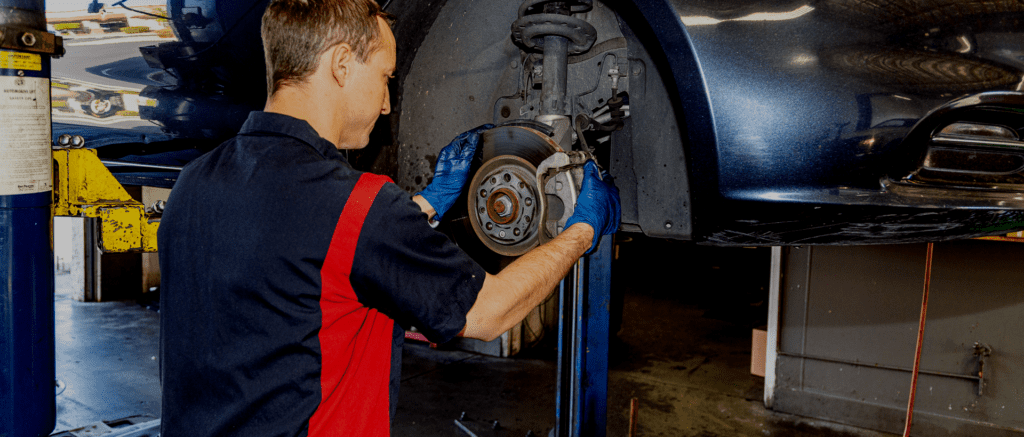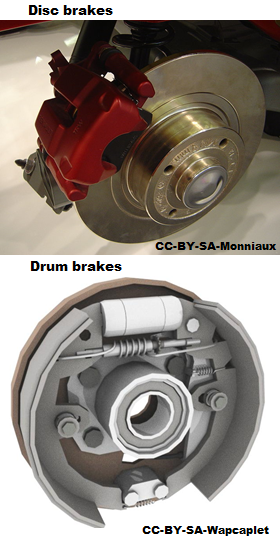
Crawford’s Auto Repair offers you Brake Services, including Brake Maintenance and Brake Repair in Chandler and nearby surrounding areas.
Schedule An AppointmentThe brakes are the most important safety feature of any vehicle. If you have a brake light illuminated on your dashboard (with the emergency brake disengaged) or if your vehicle manifests any brake symptoms, then bring it to the shop for a free brake check. Call 480-201-0740 to schedule an appointment.
The brakes are the most important safety feature of any vehicle since they allow the driver to decelerate or come to a controlled stop even after moving at high velocities. Considering how much the vehicle weighs and how often we’re in stop-and-go traffic, brakes are actually very impressive pieces of machinery.

Other parts of the braking system include the master cylinder and slave cylinders. On disc brakes the slave cylinders are the brake calipers. On drum brakes the slave cylinders are the wheel cylinders. The terminology of “master” and “slave” is standard in auto mechanics and are used to demonstrate that one cylinder takes commands from the other. (We do not use them to be culturally or historically insensitive).
Anti-lock brakes have complex electrical and hydraulic components which are used to avoid skidding wheels in a panic stop or in a poor traction condition. The anti-lock brakes (ABS) use signals from each wheel speed sensor to determine if one wheel is stopping faster than any of the others. If this occurs, the ABS control module (a computer) will signal the ABS hydraulic control unit to isolate that wheel, release brake pressure, and then pulsates the brake pressure to maintain equal speeds of all four wheels. This helps avoid skidding and maintains maneuverability during a panic stop.
The emergency brake is a crank and lock brake that is used for parking and emergencies only. In most vehicle designs the brake is engaged with either a pedal to the left of the brake pedal and accelerator, or a handle between the driver and passenger seats. The parking brake should be disengaged while driving.
For an alternative description of the brake system see Lesson 10: The Brakes of our Beginner’s Guide to Auto Repair & Maintenance online or download the ebook for free.
Brake Maintenance Schedule
Brakes are checked as part of a regular maintenance schedule for your vehicle. Generally they should be checked with each oil change and during landmark mileage checks at 30,000, 90,000 and 150,000 miles. Brakes are part of our safety check which we also frequently perform at no extra cost even when the vehicle is brought for other issues besides maintenance. The brakes should also be inspected any time there are brake symptoms.
If the brake pads are less than 20% of the original thickness then it’s time to get them replaced. If the thickness is at 20%, then you may be able to go until the next oil change; if the thickness is at 10% or less then they need to be changed immediately. Failure to change the pads could result in the need to repair the rotor which is more costly.
A brake fluid flush is NOT part of routine maintenance; it is only done when a repair is needed and don’t let other shops tell you otherwise. The fluid does not need to be flushed unless there is a leak that is contaminating the system. See 3 “Standard” Maintenance Services That Are Complete Nonsense.
Brake Warning Lights
There are various dashboard indicator lights that are related to the regular brakes, anti-lock brake system, and parking brake. We only include samples here; there are more dash lights than those found below, and your vehicle may have one that is not pictured. Refer to your owner’s manual to see the descriptions of lights found in your dashboard. Brake lights are often a circle within parenthesis or an abbreviation in text.
Brake Light
This is one of the lights that you should memorize so that you know what to do immediately without having to look it up. It’s one where you just need to react promptly and calmly while driving.
If the parking brake is disengaged and you see the brake light illuminate while you’re driving then you should assume you don’t have brakes. Turn on your hazard lights immediately. If the brakes really aren’t working then try pumping the brake pedal multiple times which may slow the vehicle, or you may have to coast to a stop. You may have to use the emergency brake. If your emergency brake is a handle between the driver and passenger seats you can try lifting the handle firmly with the button pressed, but try not to release the button until you’ve come to a full stop. If you’re driving a manual transmission vehicle you can downshift to slow the vehicle.
If the regular brakes share this light with the parking brake then make sure the parking brake is disengaged before leaving the driveway. The parking brake and Anti-Lock Brake system may have their own lights. Some of these variations are described in more detail below. They are not as serious as the regular brake light, but they should also be checked soon.
Anti-Lock Brake Indicator
These symbols are for the anti-lock brakes. The anti-lock brakes system prevents skidding in an abrupt stop. If your anti-lock brakes are not working, then your brakes will still work but they will lock during a panic stop.
Parking Brake Light Indicator
These next four symbols are for the parking brake. The parking brake should only be engaged while parked and in some vehicles, it’s also used for emergencies. EBP is a sample for the “Electronic Parking Brakes”.
Low Brake Fluid Indicator
The one with the circle and fluid at the bottom means low brake fluid. The system should be checked to see why it’s low and prevent it from getting low again. This could lead to brake failure if ignored.
Brake Pads Low Indicator
The one with dashed parenthesis and “BRAKE WEAR” mean that it’s time to change the brake pads. This could lead to more costly repairs if ignored.
Signs Of Brake Failure Which Merit Further Inspection & Brake Repair
If you answer positively to any of the following, then it’s time to have your brakes checked:
- On your dashboard a brake light is illuminated (with the emergency brake disengaged).
- You feel your vehicle is taking longer to stop than it should.
- There is a high-pitched squeal and/or grinding sound as you’re braking. The sound may or may not be audible over the sound of the car stereo. (If grinding is occurring then you may be in danger while driving and the repair job will be more expensive).
- The car pulls to one side while driving or braking.
- The brake pedal vibrates as you’re braking.
- You have to push the brake pedal all the way to the floor in order to get your car to stop OR . . .
- Your brakes engage with the slightest touch of the pedal.
If you’re experiencing any of these symptoms, then bring your vehicle to the shop for a Free Brake Inspection.
What Is Included With The Free Brake Check?
Here is a summary of the brake inspection. For more details see Free Brake Check.
- Test Drive
- Watch for brake lights on the dashboard either constantly or flashing in certain conditions
- Observe any brake symptoms while driving
- Under The Hood
- Brake master cylinder is checked for leaks
- Level and condition of brake fluid is checked
- Inspect all lines and anti-lock brake module for leaks or loose, damaged connectors
- With The Vehicle Raised on Hydraulic Lifts
- Remove all 4 wheels
- Remove drums from drum brakes
- Inspect all brake lines and hoses for signs of leaking or cracking
- Inspect caliper hardware and dust boots for brake fluid leaking
- Inspect rotors on disc brakes for smoothness (deep groves indicated it should be reconditioned)
- Check brake pad thickness on disc brakes
- Check shoe thickness on drum brakes
If the brake fluid is low then that may be an indication of a leak. Learn more about Vehicle Fluids Maintenance.
With the wheels (and drums on drum brakes) removed, you may be invited into the shop garage to go over the major findings with the technician who is inspecting your vehicle. From there you’ll be given a quote and we can discuss the best options for moving forward if you need any repairs. If there are no symptoms and the brakes are being checked routinely, then you may not need any repairs. (Hurray!)
See also What To Expect From The Mechanic During A Proper Brake Inspection.
Brake Repairs
The most common brake repair is brake pad replacement in disc brakes and brake shoe replacement on drum brakes. The pads and shoes are the friction material that are hydraulically pressed against the rotors and drums respectively to create heat. Replacing the friction material before they wear too thin is a perfect example of how proper maintenance helps you save money in the long run. If they are allowed to wear too thin and they start grinding, then the rotors and drums will need to be repaired which is much more costly.
Since the pads are occasionally allowed to wear too thin, the next most common repair is rotor reconditioning or rotor replacement. Rotor reconditioning is the cheaper of the two services but whether it can be done will depend on the level of damage the rotor has sustained.
When the brake pads are replaced and the rotor is reconditioned it’s called a brake overhaul. On drum brakes, a brake overhaul would include both shoe replacement and drum reconditioning.
The following is a more complete list of brake repairs:
Brake repairs:
- Brake pad replacement
- Brake shoe replacement
- Brake rotor replacement
- Brake rotor reconditioning
- Brake drum reconditioning
- Brake overhaul
- Brake Fluid Flush
- Brake caliper and rotor realignment
- Brake caliper replacement
- Brake hose replacement
- Brake master cylinder replacement
- Brake vacuum pump replacement
- Brake wheel cylinder replacement
- Brake light switch replacement
- Brake light bulb replacement
- Wheel hub assembly replacement
- Wheel speed sensor replacement
Emergency Parking Brake Services:
- Parking Brake Inspection
- Parking Brake Repair
- Parking Brake Cable Replacement
- Emergency Parking Barke Shoe Replacement
- Emergency Brake Control Replacement
- Parking Brake Release Cable Replacement
Anti-Lock Brake Services (ABS Inspection & Repair)
- ABS speed sensor replacement
- Anti-lock control relay replacement
- Anti-lock fuses or relay replacement
- Anti-Lock Brake Inspection (ABS inspection)
- ABS Light Inspection
- Anti-lock brake repair, ABS system repair
- Anti-lock sensor cleaning (ABS speed sensor cleaning)
- Anti-lock sensor replacement (ABS speed sensor replacement)
- Anti-lock seals and gaskets inspection and replacement
- Anti-lock fuses or relay replacement
Call 480-201-0740 To Schedule Brake Services
If your vehicle is due for brake maintenance or exhibiting any brake symptoms then bring it to Crawford’s Auto Repair for brake services. Our expert technicians will treat your vehicle as if it belonged to our own mother and we never try to sell unnecessary repairs. We simply perform a free brake inspection, give you a straightforward presentation of findings and let you decide how to proceed. Call 480-201-0740 to schedule an appointment today.


No Comments
Sorry, the comment form is closed at this time.